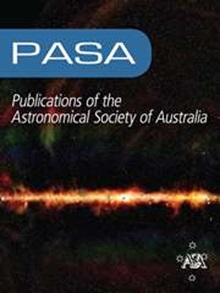用MWA-II测量全球21厘米信号:改进月球反射射频干扰的特性
IF 4.6
3区 物理与天体物理
Q1 ASTRONOMY & ASTROPHYSICS
Publications of the Astronomical Society of Australia
Pub Date : 2023-11-08
DOI:10.1017/pasa.2023.57
引用次数: 0
摘要
无线电干涉仪可以通过研究月球作为前景天空的热块来探测来自宇宙黎明(CD)和再电离时代(EoR)的天空平均信号。第一步是减轻来自月球的地球RFI反射(地球光),这会严重污染FM频段≈88 - 110 MHz,这对CD-EoR科学至关重要。我们以40 kHz的分辨率分析了72 - 180 MHz的MWA第一阶段数据,以了解三个观测夜晚地球发光的性质。我们用了两种方法来修正月球上的地球光分量。在第一种方法中,我们使用数据中两个分量的通量密度来减轻地球辐射,而在第二种方法中,我们使用基于FM目录的模拟通量密度来减轻地球辐射。使用这些方法,我们能够恢复被月球遮挡的天空中预期的银河系前景温度。我们对银河前景和月球的固有温度(T月亮)进行了联合分析,同时假设月球在三个时期具有恒定的热温度。我们用第一种方法和第二种方法分别得到了T Moon的184.4±2.6 K和173.8±2.5 K,银河系光谱指数(α)的最佳拟合值与全球天空模型相比,不确定度在5%以内。与我们之前的工作相比,这些结果改善了对银河系光谱指数和月球固有温度的限制。我们还模拟了2023年11月至12月的地球辐射atMWA,以寻找受地球辐射影响较小的合适观测时间。这样的观测窗口起到了避免地球辐射的作用,可以用来在未来利用带MWA的月球进行全球CD-EoR实验。本文章由计算机程序翻译,如有差异,请以英文原文为准。
Measuring the global 21-cm signal with the MWA-II: improved characterisation of lunar-reflected radio frequency interference
Abstract Radio interferometers can potentially detect the sky-averaged signal from the Cosmic Dawn (CD) and the Epoch of Reionisation (EoR) by studying the Moon as a thermal block to the foreground sky. The first step is to mitigate the Earth-based RFI reflections (Earthshine) from the Moon, which significantly contaminate the FM band ≈ 88 – 110 MHz, crucial to CD-EoR science. We analysed MWA phase-I data from 72 – 180 MHz at 40 kHz resolution to understand the nature of Earthshine over three observing nights. We took two approaches to correct the Earthshine component from the Moon. In the first method, we mitigated the Earthshine using the flux density of the two components from the data, while in the second method, we used simulated flux density based on an FM catalogue to mitigate the Earthshine. Using these methods, we were able to recover the expected Galactic foreground temperature of the patch of sky obscured by the Moon. We performed a joint analysis of the Galactic foregrounds and the Moon’s intrinsic temperature ( T Moon ) while assuming that the Moon has a constant thermal temperature throughout three epochs. We found T Moon to be at 184.4±2.6 K and 173.8±2.5 K using the first and the second methods, respectively, and the best-fit values of the Galactic spectral index ( α ) to be within the 5% uncertainty level when compared with the global sky models. Compared with our previous work, these results improved constraints on the Galactic spectral index and the Moon’s intrinsic temperature. We also simulated the Earthshine atMWA between November and December 2023 to find suitable observing times less affected by the Earthshine. Such observing windows act as Earthshine avoidance and can be used to perform future global CD-EoR experiments using the Moon with the MWA.
求助全文
通过发布文献求助,成功后即可免费获取论文全文。
去求助
来源期刊
CiteScore
5.90
自引率
9.50%
发文量
41
审稿时长
>12 weeks
期刊介绍:
Publications of the Astronomical Society of Australia (PASA) publishes new and significant research in astronomy and astrophysics. PASA covers a wide range of topics within astronomy, including multi-wavelength observations, theoretical modelling, computational astronomy and visualisation. PASA also maintains its heritage of publishing results on southern hemisphere astronomy and on astronomy with Australian facilities.
PASA publishes research papers, review papers and special series on topical issues, making use of expert international reviewers and an experienced Editorial Board. As an electronic-only journal, PASA publishes paper by paper, ensuring a rapid publication rate. There are no page charges. PASA''s Editorial Board approve a certain number of papers per year to be published Open Access without a publication fee.

 求助内容:
求助内容: 应助结果提醒方式:
应助结果提醒方式:


